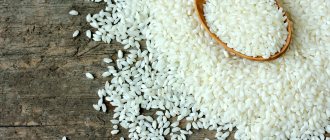Care and cleaning
1
4 725
Share
At least once in every housewife's life, small bugs appeared in the kitchen. These insects are found in food products, mainly in cereals: wheat, sugar, flour, rice, millet and buckwheat. Once settled, small bugs spoil the cereals, as a result of which the products become unfit for consumption. The saddest thing is that their appearance is noticed at the most inopportune moment. For many, kitchen “guests” are all the same. They are similar in appearance. But few people know that they are distinguished by several species based on color and preference for living in certain cereals.
There are several types of “kitchen” bugs.
- Types of insects
- Prevention measures
- Ways to deal with “kitchen guests”
- Conclusion
Cockroaches
According to the description of the dictionary V.I. Dahl, a cockroach is a crunchy insect that is found in huts. And if you add a description from Ushakov’s dictionary, the image of a cockroach will acquire new details - the insect is omnivorous and causes significant harm to the household. If there is no food, the insect survives a two-week hunger just fine or switches to eating wallpaper and book bindings. According to medical data, cockroaches can be carriers of more than twenty infections, including helminthic infestations and pathogens of gastrointestinal tract diseases.
In order to get rid of cockroaches, you first need to create uncomfortable living conditions for them: store all food in the refrigerator, sweep the floors before going to bed, thoroughly wipe the surfaces of tables, check the condition of the plumbing and eliminate water leaks. Once unbearable conditions for existence have been created, more radical measures can be taken.
There are a huge number of ways in which you can rid your kitchen of the presence of insects; all of them can be divided into mechanical (homemade traps), non-chemical (folk remedies without the use of chemicals) and chemical (attracting insecticides). Among non-chemical home remedies, baits with boric acid are very popular, among chemical ones – industrial traps with a cascade effect “Dohloks”, “Combat”, gels (Global and others), granules for preparing a solution “Regent”.
Bugs
If everything is clear with cockroaches, then strange bugs in the kitchen cause the greatest concern for housewives. Since there is not enough information on these insects, it is difficult to even simply identify what kind of bugs attacked your products.
Possible options for domestic beetles:
- The small brown bugs are wood beetles or furniture borers. Insects feed on wood, so they are only interested in your furniture, or at least crackers.
- Mucoed beetles are very similar to tree beetles (the second name is cereal beetle), although their body is more elongated and oblong. Flour eaters live in kitchen cabinets where cereals and flour are stored. Beans, cookies and dried fruits are also of interest to flour eaters.
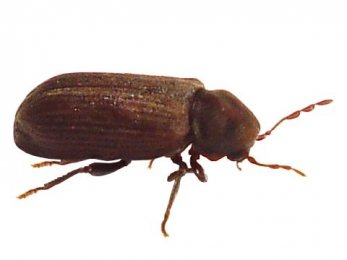
The appearance of a grinder or flour eater is a reason to conduct a thorough inventory of food supplies in the cupboard. It is better to throw away all products contaminated with insects. The next stage is disinfection of cabinets and drawers. It is best not to assume that if you thoroughly wash one cabinet where the bugs were noticed, the insects will disappear. Give your kitchen a thorough cleaning, only then can you count on some results. Use household chemicals to treat surfaces. Some housewives managed to get the bugs out after treating the boxes with vinegar. To prevent insects from appearing again, place bay leaves or peeled garlic cloves in cabinets. Unpeeled cloves can be added to containers with cereals; this will also repel pests.
Ways to deal with “kitchen guests”
If traces of the vital activity of bugs are detected, you will need to take a set of measures to eliminate them from the open spaces of your kitchen. There are several ways to get rid of “unwanted guests”:
- Products of the household industry.
- Using folk remedies.
But chemicals are not always effective and have a lot of side effects on human health. They are used only in advanced cases when folk remedies are not able to get rid of insects.
If small brown bugs appear in the kitchen, then you need to:
- Get rid of cereals where small insects have settled.
- Thoroughly wash the containers in which cereals were stored. Dishes are washed with soapy water.
You can get rid of small bugs using folk remedies using vinegar. Initially, all cereals are destroyed, then the dishes are washed with a vinegar solution. Don't worry about the smell, there won't be any.

Table vinegar is an excellent assistant in the fight against insects
Many housewives are interested in how to get rid of annoying insects at home without using household chemicals. The answer is clear: if you need to preserve the product, you will need to adhere to such actions as:
- We sort through the cereal.
- Turn on the oven to 50 degrees or heat the frying pan.
- We calcinate or fry the cereal for ten minutes, but no more, in order to avoid spoilage of the product.
Not all cereals are subject to heat treatment. Pasta, rice, buckwheat, pearl barley and millet tolerate this process normally. But this method is not recommended for use with sugar, because it will simply melt.
After this is done, the remaining supplies are packed into separate bags and taken outside the kitchen for a week. This is done for reinsurance. If surviving insects appear, they will not be able to move into other cereals and spoil them. You can get rid of white bugs by exposing the insects to cold or ventilating the room.

Ants
You can get rid of friendly lines of ants wandering into your kitchen for prey using a proven remedy for cockroaches - boric acid powder. Add a teaspoon of powder to a small portion of minced meat or mashed potatoes and roll into balls - they will be a poisonous bait for ants.
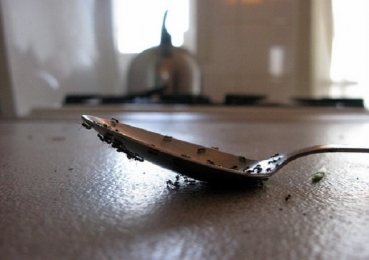
Corn flour or aromatic jam mixed with yeast is also dangerous for the stomachs of insects. Garlic aroma also repels ant communities, so you can try smearing the beaten paths leading to your table with garlic juice. In addition to home recipes, there are insecticides designed to kill insects in apartment conditions.
The flour beetle is a larger kitchen “predator” (1–1.5 cm in length), interested in cereals, flour, bran, and flakes. It usually appears in the house along with infected cereals and begins to spread. It poses a real threat to organizations involved in the cultivation and storage of cereals, producers of flour and bakery products.
Products in which insect pupae and larvae were found must be thrown away. There is no point in wasting time and painstakingly sorting through the cereal, since you will not be able to thoroughly select the excrement and skins of the larvae.
Once the contaminated food has been disposed of, you can begin to meticulously clean the kitchen. You will have to rip out everything: cabinets, bedside tables, drawers, baseboards. When the fight against the beetle is over, select glass containers for storing cereals. It is important that their lids are screwed on tightly.
Fruit midges
As soon as fruits or berries appear on the table, they are immediately surrounded by small flying insects - midges. Midges in the kitchen are fruit flies or fruit flies. They are attracted not only by slightly spoiled fruits, but in general by the processes of decay affecting products of plant origin.
The multiplication of insects can only be stopped by careful control of fruits, vegetables, berries and potted house plants. Feel free to throw away spoiled fruits or vegetables, or better yet, eat vitamin-rich foods on time.
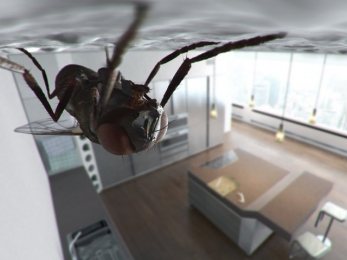
Homemade traps will help get rid of already appeared fruit flies.
Trap #1
To attract fruit flies, you will need fruit juice or pieces of rotten fruit. Place the “treat” in a container with a narrow neck, make a funnel from a sheet of paper and use it to further narrow the passage into the bottle. Having flown to the scent of the bait, the insects will not be able to get out.
Trap #2
Place a slice of watermelon or melon in a plastic bag and leave it open overnight. By morning there will be a lot of fruit flies in the trap. All that is required of you is to approach the trap as quietly as possible and close it with a quick movement of your hand. Then dispose of the insects along with the bait.
Infected cereals can throw a treat on the hostess’s table not only with flour beetles and cereal beetles, but also with cereal moth larvae. In addition, grain moths can simply fly in through an open window or enter through ventilation ducts. The domestic pest multiplies quickly, the butterfly lays larvae in cereals, grains, flour, legumes, providing the offspring with nutrition for a long time. The hatched larvae begin to quickly feed, gradually turning into an adult insect. If you don't catch it in time, the insect will quickly destroy all your supplies. The cereal moth is not a carrier of infections, since it is only interested in cereals, but you should not eat cereals contaminated with larvae. Even if you clean it of larvae and eggs, you will not be able to eliminate house insect excrement.
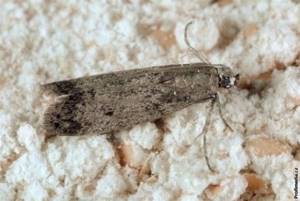
You need to fight cereal moths in the same way as other household pests of cereals: first throw away all spoiled food, and then completely disinfect the kitchen.
When the fight against insects takes place in the kitchen, the housewife’s hands are literally tied. Using strong insecticides is dangerous, as you can do more harm than help, while home methods help, but not so quickly, and sometimes they only achieve a temporary effect. All that can be advised is to stock up on reinforced concrete will and control the situation with insects in the kitchen every day: cleaning, hiding food, wiping tables, sweeping up crumbs, sifting cereals. All these standard recommendations take on individual characteristics when it is clear who exactly you have to fight with. When fighting cockroaches, ants and fruit flies, special attention is paid to proper food storage and cleaning. When fighting cereal moths, flour beetles and cereal beetles, all products must be sorted out and spoiled ones are thrown away.
But there is a second option for eliminating pests - professional pest control.
kitchens. Disinsection is an action to eliminate insects; chemicals are used to destroy them. But unlike self-treatment with available chemicals against bugs, moths, cockroaches and others, you risk the health of your family significantly less. For disinfestation of residential premises (and especially kitchens), only the safest drugs are used.
Whatever method you choose to solve the problem, try not to give up and continue the fight until the pests are exterminated.
Those bugs that we could encounter repeatedly in the kitchen can have completely different appearance, sizes, habits
, their breeding sites or differences in nutrition.
The bugs can be imago moths, or they can be the bugs themselves, which love to live in the kitchen, in cereals, flour, vegetables, dried fruits and even in the bread bin. You can consider several options for what kind of bugs can appear in the house, what they look like and what needs to be done
to free your premises from strange bugs.
Prevention measures
Every housewife would like to know a remedy for small bugs, ways to prevent spoilage of their own food and preventive measures. But unfortunately, no one is safe from insects. Even the cleanest housewives.

Even regular and thorough cleaning of the kitchen will not prevent the appearance of bugs.
Small bugs appear in the kitchen for various reasons. And most of them are associated with non-compliance with storage conditions and expiration dates of products. To prevent the appearance of bugs you should:
- Store products strictly for the specified period. This applies only to cereals sold in original packaging. The peculiarity of the packaging is that it allows you to preserve the product longer due to preliminary heat treatment. Cereals purchased by weight are stored for no more than six months.
- Keep food at optimal temperature. A damp and humid room contributes to the appearance of goosebumps. Bugs are afraid of light, so it is better to store cereals in transparent containers. For storage, rooms with low temperatures are selected: refrigerator, pantry, balcony. It is worth noting that insects die at temperatures above 50 and below 15 degrees.
- Store cereals in glass containers with screw-on lids. A prerequisite is proper sealing, protection from moisture and dry air. If this is not possible, then you need to store food in plastic bags.
- Store cereals separately from each other.
- Dried fruits should be stored in the refrigerator or freezer.

following will help prevent the appearance of bugs:
- Bay leaf.
- Garlic.
- Nails.
- Lavender.
All these components are placed in containers with products. There is an opinion that small insects in the kitchen are afraid of the smell of iron.
Important: nails with traces of rust or moisture should not be placed in cereals.
Garlic requires preliminary peeling; it does not impart a specific smell to products and does not affect the taste. To prevent the appearance of insects in cereals, bay leaves and lavender are used in the amount of three leaves.
When purchasing cereals, pay attention to the presence of suspicious objects. If small bugs have already started to appear, then they will be visible. Don't think that if the bugs don't move, they are dead. If you find objects that are not moving, you should refuse the purchase, since when you bring the product home, they may “wake up.” Unfortunately, no one is safe from purchasing already contaminated cereals. After all, if bugs are not observed, it does not mean that there are no beetle larvae.
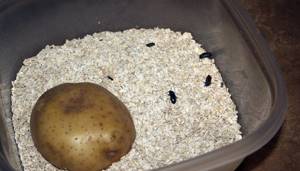
Grub-infested cereals: should now be thrown away
To “save” reserves you should:
- Place the cereals in a room with a temperature below 15 degrees.
- Carry out heat treatment of grain crops in the form of frying or calcination.
We are trying to determine what kind of bugs these are
Finding a method for getting rid of bugs in the kitchen means first correctly identifying what kind of insects they are.
have become a habit in your home and how pest control professionals deal with them.
Most often, the kitchen is attacked by such individuals as: moths, cockroaches or ants
. It is very easy to recognize them even externally, but it is still worth considering each of them separately in order to understand the methods of control that are usually effective in exterminating them.
food moth
The moth that starts in the kitchen is also called moth or food moth. These are moths, small butterflies, whose caterpillars almost always feed on cereals, flour, seeds, some spices, dried fruits, cocoa powder, crackers, cookies
– in a word, dry and bulk food products that are usually stored in the kitchen. Outwardly, such butterflies look different, depending on who eats what. If it is flour, then the flour moth has lower wings that are lighter than the upper ones. And the entirely light-colored moth, which can easily be confused with a clothes butterfly, feeds on cereals.
Wing size is usually 7-8 mm
.
When an adult builds its nest, it makes cobwebs that look like mold fibers and some lumps, pellets, in which eggs and then caterpillars will live. And, naturally, all this “good” is created by them directly in a bag or poorly closed jar of cereal or flour. The harm is not only the transfer of microbes and infections into food products, but also their complete unsuitability. After all, you can’t make porridge from moth-infested buckwheat; you just have to throw it away
. The fight against them is the use of various fungicides, insecticides or aerosols.
Molly spray
- Manufactured in Russia, Alina Nova LLC
. - How they are packaged – plastic canisters.
- Blend volume – 250 ml 5 liters
- Active inclusions in the composition – permethrin 0.45%
- Hazard class – 4, non-toxic.
- Effective.
- The price of a 250 ml bottle is 200 rubles
, a 5 liter bottle is
1250 rubles
.
CONTRA INSECT UNIVERSAL
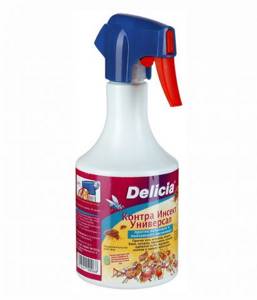
- Release of the drug by a German
. - Product form: spray.
- Volume 500 ml
- Active composition – permethrin 0.5%.
- Efficiency – very effective on adults
- Toxicity – class 2, quite dangerous.
- Cost 600 rub
.
Pest control measures
If you find bugs in your kitchen, how to get rid of them? We need to check all food supplies. If they are severely infested, they are thrown away. If the insects do not have time to reproduce, the following measures are taken:
Temperature treatment
They influence beetles using temperature conditions. Low temperatures (-5...-11 degrees) have a negative effect. The rules apply: the higher the value of this parameter, the better. If there are bugs in the kitchen in winter, food supplies are taken outside to the balcony. At other times, cereals, nuts, dried fruits, flour, etc. are placed in the freezer. It is recommended to leave food there for several hours, or even for 2-3 days.
Use an increase in temperature. The higher the value of this parameter, the faster the pests will die. You can send the food to the oven and set the temperature within +50...+60 degrees.
Surface treatment
All cabinets and other furniture need to be cleaned. Then the surfaces are treated first with soap and then with vinegar solution.
Storing food in containers
You need to get rid of insects taking into account their characteristics. Despite the rather powerful oral apparatus, which allows pests to grind hard food and penetrate food bags, they will not be able to crawl into a tightly closed container. This means that it is recommended to store cereals, flour and other bulk products in closed jars (ceramics, tin or glass).
Check the tightness of the lids on jars and containers, and make sure that the plastic containers are intact.
Useful video: How to get rid of bugs in cereals?
Cockroaches
There are many different types of cockroaches, and they differ in the area where they live. The largest is the Madagascar cockroach, whose body length reaches 9 cm. In the European part of the Eurasian continent and throughout Russia, you can most often find the red cockroach (or, as it is also called, the Prusak) in apartments and houses, as well as the black cockroach. These creatures bring harm to humans in the form of carriers of dangerous diseases - gastroenteritis, dysentery and even cholera
.
They are easily detected - at night, when the lights are turned on suddenly, these pests scatter in all directions. The most effective means of the folk approach are considered to be bait cakes prepared for cockroaches from boric acid and egg yolk
.
Deltrin
- Produced in Russia (Alina Nova LLC).
- The form of the product is concentrate.
- Mass volume – 1 liter
- Two main components - Deltamethrin (2,5%).
- Toxicity – class 3, low hazard, but should be kept away from children and pets.
- How to use
- dilute 10 ml of product per 1 liter of water and spray on the surface where cockroaches are most noticeable, along baseboards, on the back walls of cabinets, under the sink, and so on. - Efficiency - a nerve-paralytic effect leading to the death of insects occurs approximately 10-12 hours
after they have eaten the drug. - When the package is opened, the drug is stored for 2 years, no longer.
- Cost – 1350 rubles
.
Medilis-I
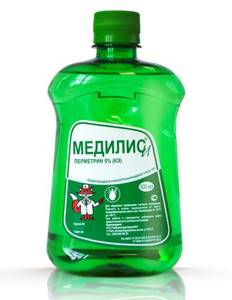
- Manufacturer – Russia, Moscow
. - Release form: concentrate.
- Aerosol volume – 500 ml.
- Active substances – perimeter 25%
. - Toxicity is average.
- Efficiency - kills all crawling pests.
- Price – 1200 rub
.
Ants
Ants in the kitchen can appear in different ways: someone complains about red little “beauties”, someone has encountered aggressive black individuals
, similar to street ants, and some are bothered by small brown goosebumps.
They love to attack sugar bowls, bowls with honey, jam - in a word, where there is something aromatic and sweet, they will be there too. But not only that - they also love to eat chips, sausage and other smelling leftover food. If you don’t want to create a kind of “living corner” in your place, then it’s better not to leave any leftover food anywhere
; immediately pick up anything that’s dropped on the floor, otherwise they’ll immediately come running.
DELICIA powder
- The product is produced in Germany.
- The active main substance is Chlorpyrifos 2%.
- Toxicity – low hazard.
- How it is used - crumbles in places where insects accumulate
- Weight 125 grams.
- The jar is enough to process 250 sq.m.
- Cost – 300 rub.
Cucaracha concentrate
- Produced by Russia
. - Release form – concentrate.
- Volume in one package is 1 or 5 liters.
- The drug is of moderate toxicity
to humans. - Active ingredient: Malathion (karbofos) 10%, Cypermethrin 20%
- Price for 1 liter 1550 rubles, for 5 liters 6500 rubles
How do bugs get into the kitchen?
Having discovered bugs in the kitchen, we involuntarily think about how they got to us. Don't blame yourself for being careless when cleaning or storing food incorrectly. Even with the most thorough cleaning of cabinets and proper maintenance of all containers with cereals and flour, you are not immune from the appearance of beetles. The fact is that insects come into the house with purchased products.
Millet infected with bugs
Everyone understands that most parasites come to us from the outside, from our environment. It's the same with kitchen bugs. The primary infestation of future cereals by beetles occurs during the period of growing, harvesting and transporting cultivated crops. Unscrupulous producers neglect heat treatment of products, store them without complying with standards, and thereby contribute to the colonization of ready-made cereals and flour with insect larvae.
Bugs especially often appear in the kitchen along with pasta, dried fruits, flour and cereals bought in bulk. This is due to the fact that loose products absorb moisture well, creating an ideal environment for the development of previously deposited beetle larvae. By placing such products next to packaged ones, you unwittingly contribute to their dispersal. Unfortunately, even vacuum packaging does not guarantee against contamination of the product by harmful insects if the manufacturer does not comply with the rules for their storage.
Sometimes, along with the bugs, another attack, small midges, may appear. The article “How to get rid of midges in the kitchen” will help you get rid of them.





